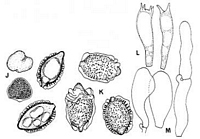|
 Hymenogaster nanus Hymenogaster nanus
BiostatusAbsent from region
Images (click to enlarge)
Caption: Hymenogaster nanus:
J habit and section (Beaton 54) x 1;
K spores x 1750; L basidia x 1000; M epithelial
elements x 1000. |
Article: Beaton, G.W.; Pegler, D.N.; Young, T.W.K. (1985). Gasteroid Basidiomycota of Victoria State, Australia. 3. Cortinariales. Kew Bulletin 40(1): 167–204.
Description: Gasterocarp 1-2 cm diam., globose, ellipsoid
or irregular, basally attached. Peridium about 1 mm thick, dingy white, drying
light greyish brown, smooth, not viscid. Gleba light brown, drying darker, loculate,
of globose or ellipsoid, empty or partially full chambers, with some radial
arrangement. Tramal plates 100-150 µm thick, hyaline or pale brownish, consisting
of a broad hymenophoral trama and poorly developed subhymenial layers; clamp-connexions
present on all hyphae. Sterile base scarcely developed or absent.
Spores 13-16 x 7.5-8.5(14 ± 0.7 x 8 ± 0.5)
µm (excl. myxosp.), Q = 1.75; obovoid to narrowly limoniform, often but not
always with a mucronate apex, golden brown, with a thickened wall bearing a
fine verrucose ornamentation, overlaid by a loose, hyaline myxosporium which
often becomes detached at the base and or the apex. Basidia 32-27 x 7.5-9.5
µm, clavate, bearing mostly two short, tapering, straight sterigmata, but also
forms with one or four sterigmata present; also numerous, immature, ellipsoid
basidia. Hymenophoral trama regular, hyaline, of parallel, thin-walled hyphae,
3-14 µm diam. Subhymenial layer narrow, 10-15 µm wide, interwoven or indistinctly
pseudoparenchymatous. Peridiopellis up to 200 µm thick, consisting of a loose
and disrupted epicutis, with erect or semi-erect, inflated clavate elements,
12-40 x 6-14µm, sometimes producing an indefinite epithelium.
Notes: Hymenogaster nanus is extremely similar,
and closely related, to H. albus, but differences in the narrower spores,
the lack of a true epithelium in the peridiopellis, a poorly developed subhymenial
layer, and a paler coloured gleba, are sufficient to maintain a distinction
between the two species.
|